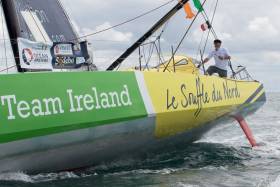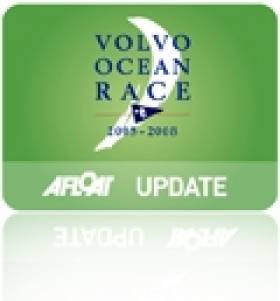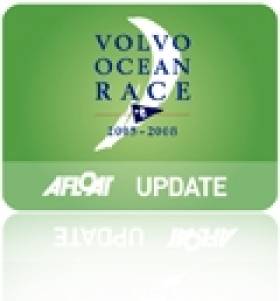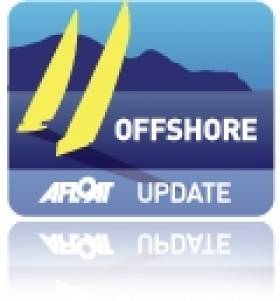Displaying items by tag: Cape Horn
2024 Cape Horn Hall of Fame Nominations Close Now Open
The International Association of Cape Horners (IACH) has announced that nominations for the 2024 Cape Horn Hall of Fame Awards are now open.
The awards aim to honour the most accomplished sailors who have sailed around the challenging Cape Horn, the southernmost tip of South America.
The IACH has already received nominations for some significant names in the sailing world, including the first woman to win any round-the-world race, Kirsten Neuschäfer, and renowned French sailor Loïck Peyron. However, the public still has until 30th April to submit their nominations.
The IACH, which organises the awards, has an independent judging panel, including the chairman and renowned sailor, Sir Robin Knox-Johnston. The panel will select a shortlist of 20 contenders, which will then be voted on by the entire IACH membership to select the top six inductees.
The award ceremony will be held in Les Sables d'Olonne, France, on 26th October, during the 2024/25 Vendée Globe Race build-up. The ceremony will take place at the Cape Horners Yacht Club, also known as "Le Carre," which opened last year. The Club has a bar, dining room, and terrace overlooking the Vendee Globe marina, and it holds a collection of memorabilia from famous circumnavigations.
The IACH Cape Horn Hall of Fame honours board currently lists 26 famous Cape Horners, including Dame Ellen MacArthur, Jeanne Socrates, and Grant Dalton.
What Irish Sailors Can Join the 2023 Cape Horn Hall of Fame?
True to its tradition of hosting world-famous sailors, Les Sables d'Olonne, the global capital of single-handed ocean racing, is now home to the International Association of Cape Horners Cape Horn Hall of Fame.
The International Association of Cape Horners (IACH) is calling for nominations to be included in the 2023 Cape Horn Hall of Fame to join the names of 28 famous sailors inaugurated last year at a ceremony held in Les Sables d’Olonne, France, the home of solo sailing.
Sir Robin Knox-Johnston, Chairman of the independent Cape Horn Hall of Fame Selection Committee, says: “This year, we are looking for Cape Horners past and present who have made a significant contribution to the sport of sailing, either solo or leading a crew around the world’s most infamous Cape.”
His committee, which includes veteran French sailor Jean-Luc van den Heede (deputy-chairman), American navigator Stan Honey, and fellow circumnavigators Dee Caffari (UK) and Dilip Donde (India), will review each nomination and select the best 20 names for a vote by members of IACH to determine the final six to be inducted into the 2023 Cape Horn Hall of Fame.
 Aug 2022. The first induction of sailors into the Int. Assoc. of Cape Horners (IACH) Cape Horn Hall of Fame, held in Les Sables d’Olonne, France, the permanent home of the IACH Cape Hall Horn of Fame. Left to right: Yannick Moreau, the Mayor of Les Sables d'Olonne; Ashley Manton, Chairman of IACH; Jean-Luc van den Heede, Vice President of IACH. Photo: Tim Bishop/PPL
Aug 2022. The first induction of sailors into the Int. Assoc. of Cape Horners (IACH) Cape Horn Hall of Fame, held in Les Sables d’Olonne, France, the permanent home of the IACH Cape Hall Horn of Fame. Left to right: Yannick Moreau, the Mayor of Les Sables d'Olonne; Ashley Manton, Chairman of IACH; Jean-Luc van den Heede, Vice President of IACH. Photo: Tim Bishop/PPL
The Cape Horn Hall of Fame nomination form can be downloaded from the IACH website. Submissions close on April 30, 2023. The 2023 Cape Horn Hall of Fame induction ceremony will occur in Les Sables d’Olonne in September.
“We are very pleased to have the IACH Cape Horn Hall of Fame as a permanent fixture in Les Sables d’Olonne,” says the City Mayor, Yannick Moreau, adding. “The Board of Honour pays tribute to these men and women who have shown such bravery and courage. It has also become a pilgrimage for recipients and their families to visit, building on our reputation and maritime importance as a home for the Vendée Globe and Golden Globe solo round-the-world races.”
Ashley Manton, Chairman of the International Association of Cape Horners, adds, "This is now an important event in the sailing calendar, encouraging future generations to follow in the footsteps of their elders in setting new records in round-the-world sailing”.
Names already honoured on the IACH Cape Horn Hall of Fame
- Willem Schouten (1567-1625), Netherlands
- Jacob Le Maire (1585-1616), Belgium
- Vice Admiral Robert Fitzroy (1805-1865), England
- Capt. Vern Verner Björkfelt (1900-1982), Finland
- Capt. Thomas Carter (T.C) Fearon (1813 - 1869), USA
- Capt. Adolph Hauth, Allemagne
- Capt. Louis Allaire (1880-1949), France
- Alan Villiers (1903-1982), Australia
- Vito Dumas (1900-1965), Argentina
- Marcel Bardiaux (1910-1958), France
- Sir Francis Chichester (1901-1972), England
- Sir Alec Rose (1908-1991), England
- Sir Robin Knox-Johnston (1939-), England
- Bernard Moitessier (1925-1994), France
- Sir Chay Blyth (1940-), Scotland
- Ramon Carlin (1923-2016), Mexico
- Éric Tabarly (1931-1998), France
- Cornelis van Rietschoten (1926-2013), Netherlands
- Dame Naomi James (1949-), New Zealand
- Kay Cottee (1954-), Australia
- Jon Sanders (1939-), Australia
- Philippe Jeantot (1952-), France
- Titouan Lamazou (1955-), France
- Sir Peter Blake (1948-2001), New Zealand
- Dilip Donde (1967-), India
- Stan Honey (1955-), America
- Dee Caffari (1973-), England
- Jean-Luc Van Den Heede (1945-), France
Enda O’Coineen Set To Round Cape Horn Solo This Weekend
In the coming 24 hours, Enda O’Coineen is on course to sail solo around the notorious Cape Horn as he endeavours to complete his solo sailing lap of the planet.
Enda restarted his voyage in late January a little over a year since his Vendée Globe challenge came to an abrupt end, when his mast came crashing down some 180 miles south of New Zealand.
Having sailed more than half-way around the world from Les Sables in France, Enda was determined to finish what he started.
Initial plans to repair his boat changed when the opportunity arose to combine his efforts with another retired Vendée Globe team and merge as Le Souffle du Nord Kilcullen Team Ireland, with the mission to sail back to France and unofficially finish the race.
This weekend will be only one of a few recorded times that an Irish sailor has rounded the southern tip of the South American continent.
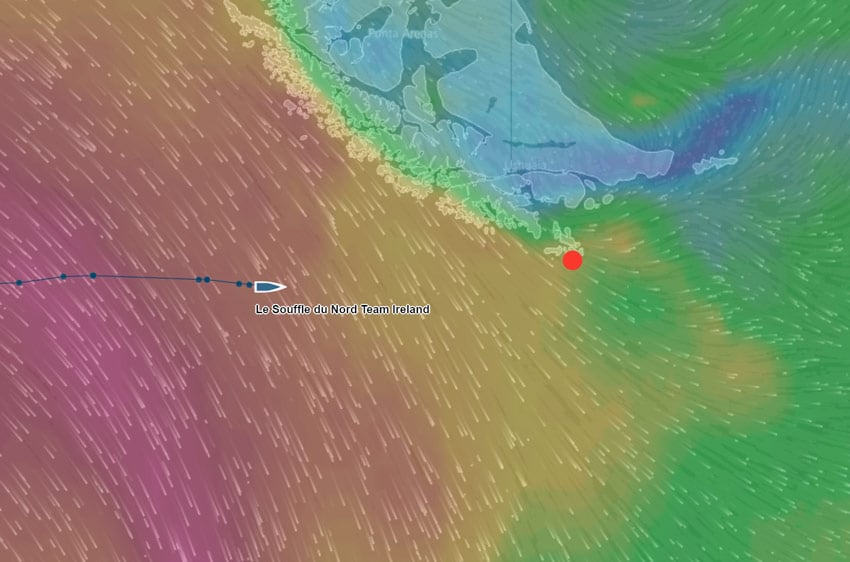
Speaking about historic event, Enda O’Coineen said: “Cape Horn is one of, if not, the most feared pieces of land to round on the planet. And it is certainly living up to its reputation as I approach with 60kph winds and roaring seas hurtling me towards the great cape.
“This will hopefully be the coldest and wildest weather I will encounter as I then turn north and start the final leg up the Atlantic Ocean and into Les Sables d’Olonne to finish what I started.
“It’s hard to explain why I put myself in this position, alone, cold, and exhausted as the bottom of the earth but as any sailor or adventurer knows as soon as you reach your destination and accomplish your goal you quickly forget about the hardship.”
Enda added: “Right now I am living on the edge, moment by moment. Having the joint backing of two teams and flying both the Irish and French flags is an honour. The work of Le Souffle du Nord and the Atlantic Youth Trust keeps me motivated during the lows.”
The timing of the rounding coincides with summer in the Southern Hemisphere, but the latitude and converging seas make Cape Horn a daunting prospect year-round.
For live tracking of Enda’s voyage visit www.teamireland.ie.
Volvo Ocean Race Fleet Approach Cape Horn
#vor – The Volvo Ocean Race fleet, battered but unbroken as they battle through the Southern Ocean, face the toughest 48 hours of the nine-month marathon as they approach Cape Horn on Monday.
The region is the only time in the 38,738-nautical mile race where the boats are likely to see icebergs, despite the ice limits set by organisers, and a huge storm is building up behind to chase them on their way (see details here).
Early on Saturday (0640 UTC), the Chinese boat Dongfeng Race Team, skippered by Frenchman Charles Caudrelier, led the leg from Auckland to Itajaí, Brazil, but by less than 10nm from four other crews.
Caudrelier admitted that the stress has become "wearing' on his eight-man team.
"I think it's unique in the history of the Volvo Ocean Race (launched in 1973) to have a fleet battling like this in these latitudes," he wrote in his blog on Saturday.
"Tomorrow, we'll be even further south and the water temperature is going to drop. I'm expecting the hardest part of this race in the next 48 hours."
Dongfeng were one of three boats to crash over on their sides midway through the Southern Ocean on the 6,776nm leg – a so-called 'Chinese gybe'.
Thankfully, all the crews avoided anything more serious than cuts and bruises and damage to boats have been repaired on the move.
After some 3,000nm miles of sailing in the toughest leg of the race, Dongfeng lead by just 5.1nm from Dutch boat Team Brunel (Bouwe Bekking/NED) with overall leaders Abu Dhabi Ocean Racing (Ian Walker/GBR), MAPFRE (Iker Martínez/ESP) and Team Alvimedica (Charlie Enright/USA) no more than 4nm further adrift.
The all women's crew of Team SCA (Sam Davies/GBR) were nearly 100nm behind that pack, but gaining all the time in stronger winds.
They and MAPFRE also suffered Chinese gybes on Tuesday. The leg is expected to conclude around April 5-6 after three weeks of sailing from New Zealand.
In all, the boats will sail nine legs and visit 11 ports. They finish the race on June 27 in Gothenburg, Sweden.
Groupama Try Out a New Watch System
#VOLVO OCEAN RACE - Has the Groupama sailing team adopted a new simplified watch system, keeping just one man on deck to handle the vessel - as demonstrated by Ireland's Damian Foxall in the video above?
Don't worry - it's just a prank for April Fool's Day yesterday!
The yacht and its full compliment of crew have rounded Cape Horn and are currently in overall second place as the Volvo Ocean Race fleet heads to Itajaí in Brazil on the fifth leg and longest passage of the race.
Groupama and PUMA are currently battling for first place on the leg, with Telefónica hot on their heels after making up 180 miles in just 36 hours with speeds near double those of the frontrunners.
Velux 5 Oceans: Windy Start to Ocean Sprint 3
The Velux 5 Oceans website has posted a video preview ahead of the third ocean sprint stage in the marathon round-the-world yacht race.
The third stage, which kicks off tomorrow, will take the four competing yachts across the Pacific Ocean from Wellington, New Zealand to Punta de Este in Uruguay.
Sail World reports that northerly gales are expected to buffet the boats from the off as they set out on the incredible 6,000-mile route, which will take them to Nemo Point - the most remote spot in the world - and the notorious challenge of Cape Horn.
American Brad Van Liew, skipper of Le Pingouin, is currently in the lead having won the previous two ocean sprints in the 30,000-mile race.


























